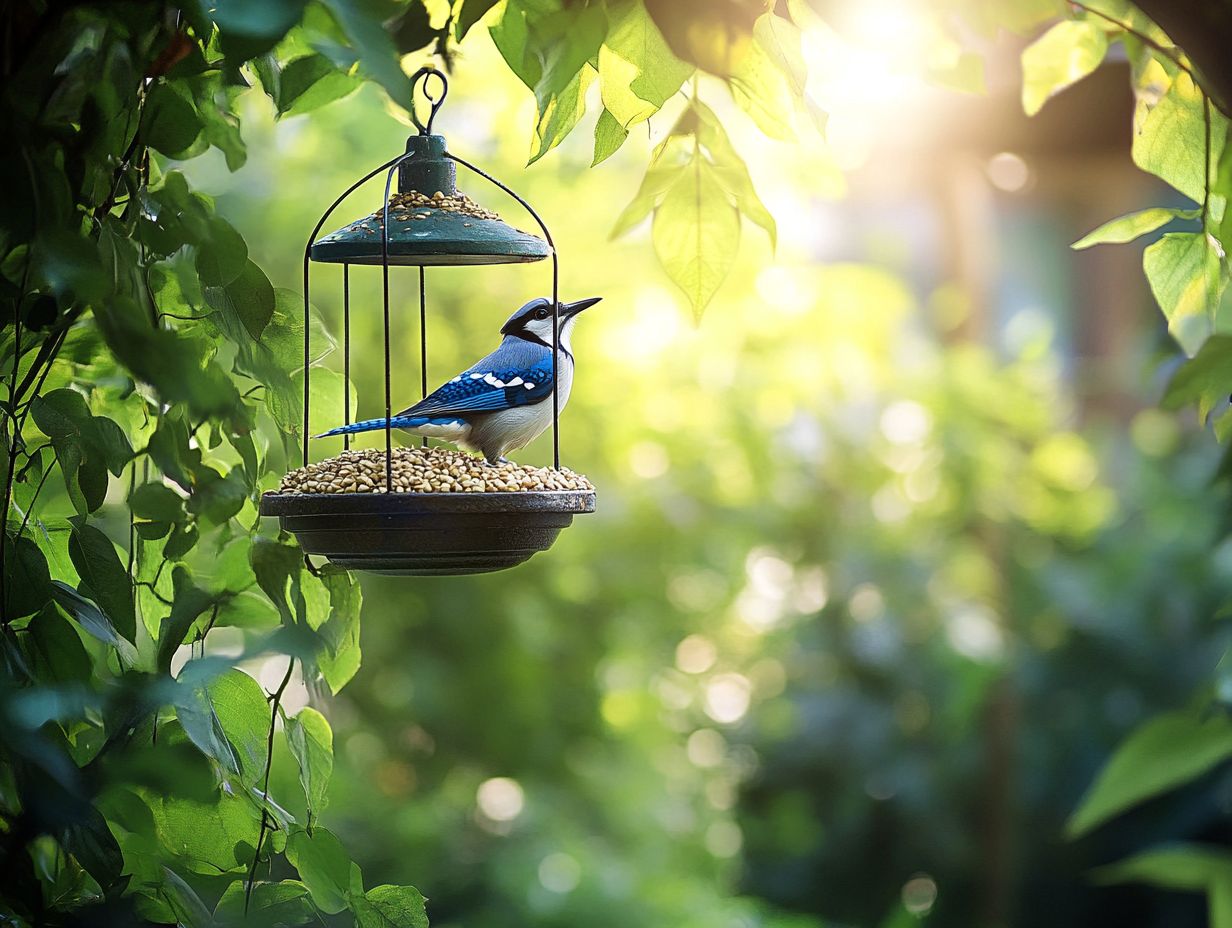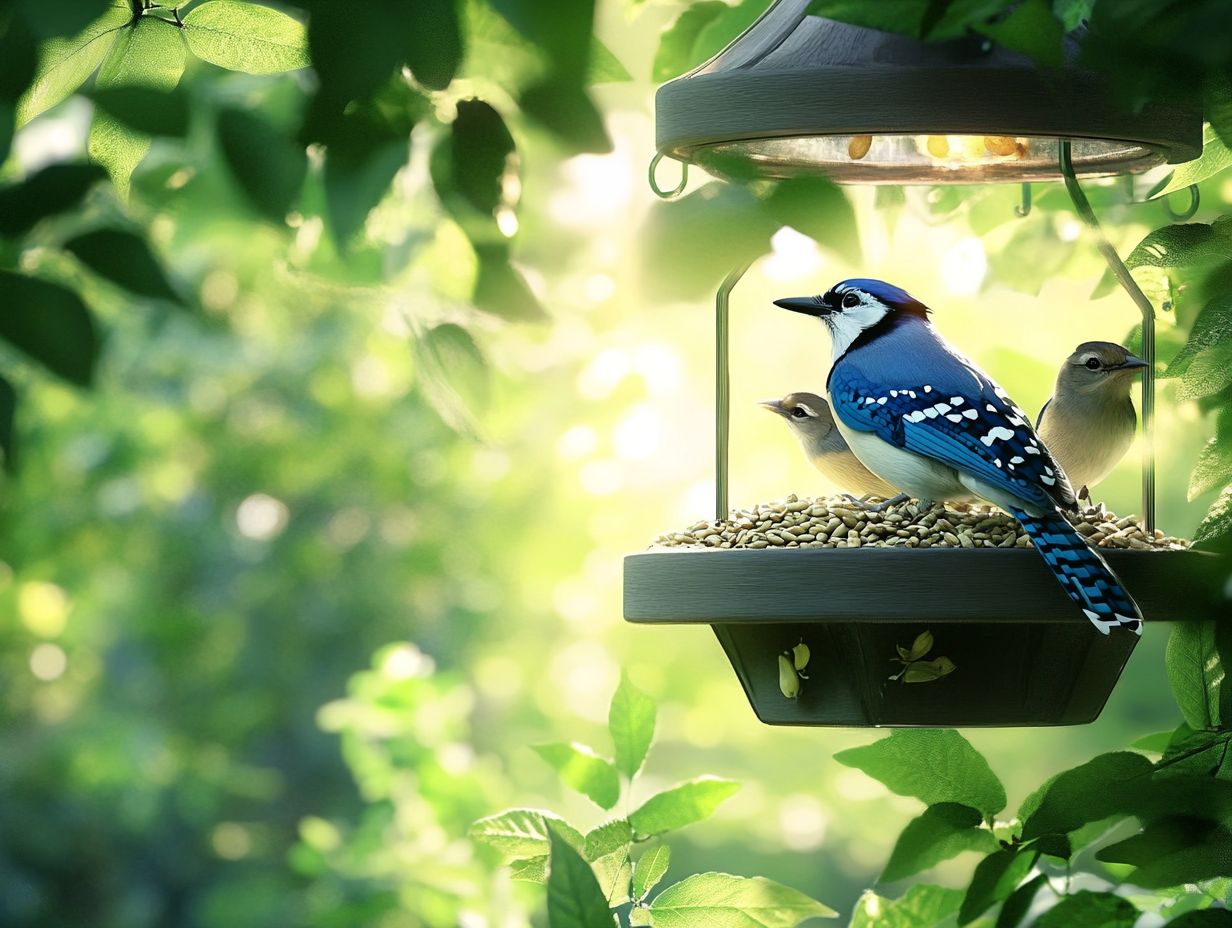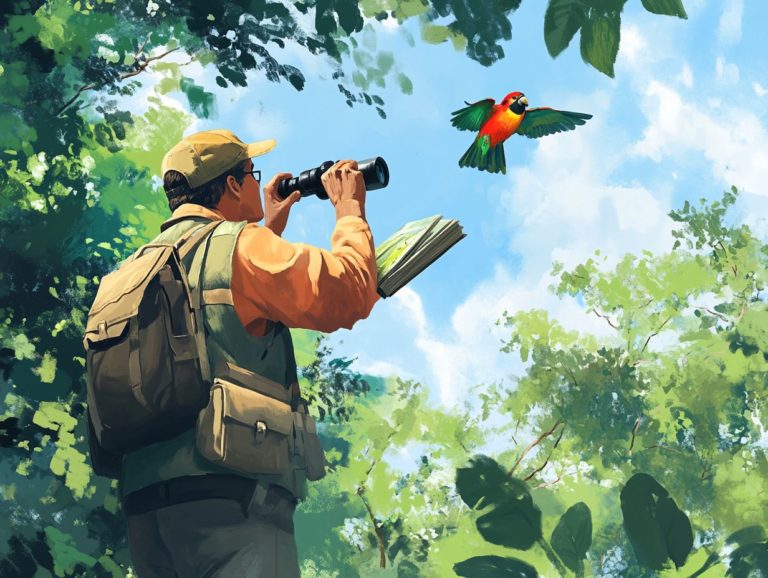What is the Purpose of Bird Feeders?
Bird feeders are not merely decorative pieces in your garden; they play a crucial role in attracting and nurturing local bird populations.
This article delves into the myriad benefits of using bird feeders, from enhancing the beauty of your outdoor space to supporting the birds that call your area home. You ll learn about the different types of feeders available, how to select the perfect one tailored to your needs, and essential tips for effective installation and maintenance.
You’ll also discover how to address common challenges, ensuring that your yard becomes a safe haven for the feathered visitors. Whether you’re an experienced birdwatcher or just starting out, this guide will empower you to elevate your bird-feeding experience to new heights.
Contents
Key Benefits:

- Bird feeders attract and help birds by providing a reliable source of food, contributing to their survival and well-being.
- Properly selecting, setting up, and maintaining bird feeders can increase their effectiveness and prevent common problems like pests.
- There are various types of bird feeders available, so consider factors like bird species, feeder designs, and location when choosing the right one for your needs.
What are Bird Feeders?
Bird feeders are expertly crafted structures that provide a reliable food source for wild birds. They allow you to enjoy watching birds in your backyard.
By offering small black seeds that many birds love, these feeders attract a delightful variety of species, including hummingbirds, cardinals, and finches, enriching the ecosystem across North America. The smart placement and thoughtful design of these feeding stations play a crucial role in supporting the health and survival of backyard birds, especially during those chilly months when food becomes scarce.
There are several types of bird feeders available, each tailored to meet the unique needs of different species.
- For instance, tube feeders with small feeding ports are perfect for finches and siskins, allowing them to cling to the perches as they feast on nyjer seeds.
- Platform feeders, on the other hand, welcome larger birds like jays and doves, providing ample space for them to perch and enjoy their meal.
- Specialized suet feeders attract woodpeckers and nuthatches, offering high-energy fat that is especially beneficial during winter.
By selecting the right design and food, you can witness a lively array of avian visitors, each adding to the vibrant tapestry of local wildlife.
Benefits of Using Bird Feeders
Utilizing bird feeders offers a wealth of advantages for both wild birds and enthusiasts like yourself. This creates a unique opportunity to engage with nature while nurturing a vibrant ecosystem.
These feeders are vital for increasing survival rates of parent birds and their fledglings, especially during challenging weather conditions.
Experience the thrill of birdwatching and become a part of nature s wonders while contributing to their well-being.
Attracting and Helping Birds
Attracting and nurturing birds is the primary purpose of bird feeders, serving as essential feeding stations for the charming visitors in your backyard. By implementing effective feeding strategies like using black oil sunflower seeds and suets you can draw in a delightful variety of species while delivering the vital nutrition they need to thrive.
To truly maximize feeder usage, it s essential to understand the preferences of different bird species. For example, finches have a particular fondness for nyjer seeds, while woodpeckers are irresistibly drawn to suet cakes, which provide the high-fat content they need during those chilly months.
Positioning your feeders in a sheltered area, surrounded by trees, not only offers birds a safe haven from predators but also attracts species like chickadees and nuthatches that appreciate a little cover. Opting for platform feeders can create an inviting space for ground-foraging birds like doves and juncos, ensuring you cater to a diverse avian crowd.
Don t miss the chance to witness the beautiful variety of birds in your backyard! Start setting up your bird feeder today and enjoy the vibrant life that fills your garden!
Types of Bird Feeders

Bird feeders are available in an impressive array of designs and formats. Each one is carefully designed for different foods and bird types.
As a bird enthusiast, it is essential to select the right feeder that harmonizes with your backyard ecosystem.
You ll encounter common types such as tube feeders, which are designed for thistle seeds. Platform feeders are perfect for mixed seed blends, while nectar feeders attract hummingbirds.
Each of these feeders draws a variety of wild birds to your garden. They enhance the beauty and vibrancy of your outdoor space.
Overview of Different Feeder Designs
Exploring various feeder designs unveils the thoughtful innovation behind effective feeding stations. These are tailored to meet the diverse needs of wild birds.
From hanging feeders and platform feeders to specialized nectar feeders, each design serves a unique purpose in attracting and supporting different species.
This positively impacts the ecosystem.
These feeders provide essential nutrition. They also enrich your backyard experience as an avid bird watcher or nature enthusiast.
Tube feeders attract finches and other small seed-eating birds. Their narrow feeding ports conveniently keep larger birds at bay.
Suet feeders cater to woodpeckers and insectivorous birds. They offer a high-energy food source that is vital during the colder months.
This thoughtful approach ensures a harmonious balance of bird species thriving in your backyard. It creates a vibrant and dynamic environment for both the birds and you, the keen observer.
Choosing the Right Bird Feeder
Selecting the perfect bird feeder is crucial for successfully attracting and nurturing your local bird population. It requires thoughtful consideration of several key factors.
Start by identifying the types of wild birds you want to entice. Next, evaluate the food sources available throughout the year.
Lastly, consider the feeder’s design to ensure it aligns with both the birds’ feeding habits and the visual appeal of your backyard.
Factors to Consider
When contemplating the best bird feeder for your backyard, there are several factors to consider. Think about the environmental impact of the feeder’s materials and the specific species you want to entice.
These considerations will guide your decision-making process.
Choosing the right feeder is crucial! Birds have specific food preferences that you must understand.
Placement is important; feeders should be positioned in safe spots to protect the birds from predators. They should still allow for easy access for feeding.
Regular maintenance is essential to keep your feeders functional and inviting. This includes cleaning and refilling.
Don t overlook the local pest population. Certain feeder designs can help deter unwanted visitors, ensuring your feathered friends can dine in peace.
Setting Up and Maintaining Bird Feeders

Setting up and maintaining bird feeders is essential for enticing backyard birds to visit regularly. This ensures that your feeding stations remain clean and functional.
Start by choosing a great spot for your feeders. Make sure they are secure and easy to access.
Regularly check on the food supply, cleanliness, and any necessary repairs. This will help you create a successful and enjoyable bird feeding experience.
Get ready to welcome beautiful birds into your backyard! Choose the right feeder today!
Tips for Proper Installation and Care
To enhance the effectiveness of your bird feeders, consider these tips for installation and care that will elevate your experience and delight the visiting birds. Focus on feeder placement. Ensure it remains visible yet sheltered from harsh elements.
Regularly clean and refill your feeders to keep food available for the birds. This helps keep your feathered friends healthy year-round.
Select the right types of feeders and seeds tailored to the bird species in your area. This will draw in a delightful variety of visitors, from vibrant finches to striking cardinals and curious chickadees. Opt for feeders with multiple perches or those specifically designed for certain birds; this will welcome a wider variety of beautiful guests to your feeder!
Adding a nearby water source, like a birdbath, not only entices birds but also promotes their well-being by providing essential hydration. Record the species you see to enjoy a richer birdwatching experience and refine your feeding strategies. This fosters a vibrant and welcoming environment for these enchanting creatures.
Common Bird Feeder Problems and Solutions
Common bird feeder problems can disrupt your feeding experience and deter wild birds from gracing your backyard. By understanding these issues and their solutions, you can elevate your bird feeding efforts.
Challenges like attracting unwanted pests think squirrels and mosquitoes or dealing with feeder clogs can undermine the effectiveness of your feeding stations. Addressing these concerns ensures a more enjoyable and fruitful birdwatching experience.
Dealing with Pests and Other Issues
Dealing with pests and other annoyances is a common challenge for anyone who enjoys bird feeding. Unwanted visitors like squirrels and mosquitoes can disrupt the feeding environment and discourage wild birds from stopping by. To tackle these issues, implement strategies such as using squirrel-proof feeders and maintaining cleanliness at your feeding stations. This way, you can keep the focus on attracting and supporting healthy birds.
To manage these pesky critters, explore various feeder designs that feature baffles barriers that keep squirrels from climbing to the feeder or weight mechanisms to keep squirrels at bay while allowing smaller birds easy access. Regularly clean your feeders to prevent food spoilage, as moldy seeds can attract insects and diseases that could harm your feathered friends.
Routine maintenance, like washing feeders and replacing old seed, enhances the overall feeding experience and creates a safe and inviting environment for your avian visitors. By fostering a healthy feeding habitat, you significantly increase your chances of attracting diverse bird species to your yard.
Frequently Asked Questions

Why Are Bird Feeders Important?
The purpose of bird feeders is to provide a source of food for wild birds, especially during times when natural food sources may be scarce.
Why Should I Use Bird Feeders?
Bird feeders are a great way to attract a variety of bird species to your yard, giving you the opportunity to observe and enjoy them up close.
What Types of Birds Can I Attract with Bird Feeders?
Bird feeders can attract a wide range of bird species, including songbirds, finches, woodpeckers, and even hummingbirds.
How Do I Choose the Right Bird Feeder?
The type of bird feeder you choose will depend on the types of birds you want to attract and the food you want to offer. Different feeders are designed for different types of birds and foods.
What Type of Food Should I Put in My Bird Feeder?
The type of food you put in your bird feeder will depend on the types of birds you want to attract. Some popular options include sunflower seeds, suet, and nectar for hummingbirds.
Do Bird Feeders Have Any Other Benefits?
In addition to providing a food source for wild birds, bird feeders can also help control insect populations and provide entertainment and relaxation for bird watchers.
Start setting up your feeders today and enjoy watching the birds flock to your yard!



